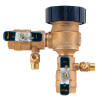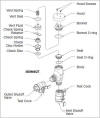PVB (Pressure vacuum breaker) is designed to prevent back-siphonage of contaminated water into a potable system. Often PVB’s are used as fixture isolation with an RP at the service to the building. PVB’s must be installed 12″ higher then the downstream piping.
*This article is only meant as a summary of the testing procedure, you are responsible to test backflow preventers to the standard of your authority having jurisdiction.
PVB Testing Steps
- Air inlet valve test – The air inlet valve must open at or before the internal pressure is 1 psi above atmospheric pressure.
- Check valve test – The check valve must close tight in the direction of flow with a 1 PSI differential.
- Static line pressure – you must record the static water pressure at the time of the test valve #1 from which a sample can be drawn for testing or visual examination.
DCVA Maintenance Hints
- Always use manufacturer’s replacement parts.
- Rubber parts should be changed every 5 years.
- Always bleed the test valve to remove dirt before attaching your gauges.


